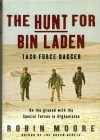Task Force Dagger: The Hunt for Bin Laden
Written by: Robin Moore,
Random House, New York, 2003,
ISBN: 9780375508615, 372pp.
Reviewed by: Captain Brett Chaloner, Royal Military College, Duntroon
Robin Moore will never be renowned as one of the world’s great military historians; however, as the author of Task Force Dagger, he does what only an American author can do. He tells a story with great passion and fervour, sprinkled with good old ‘Uncle Sam’ ideology. This is a story of which the World War II and Vietnam War storyteller Brigadier S. L. A. Marshall would be proud. Task Force Dagger is not another Bravo Two Zero. It is, nonetheless, an engaging study that, when stripped of its hyperbole, outlines the detailed and complex story of the 5th Special Forces Group’s operations in Afghanistan between October 2001 and April 2002.
The 5th Special Forces Group (5th Group) is responsible for the conduct of Special Operations in the US Central Command Area of Operations, which includes the Middle East and Afghanistan. By the admission of their Commander, Colonel John Mulholland, ‘... Afghanistan was new to the 5th Group ... [it] was not an area that the United States had focussed on since the end of the Soviet era after they pulled out at the end of the 80’s’. Following the bombing of the World Trade Centre on 11 September 2001, Joint Special Operations Task Force ‘Dagger’ (TF Dagger) was the organisation spearheaded and commanded by 5th Group. It was assembled from predominantly US Army, Navy and Air Force Special Operations components with elements of the British SAS attached. Its mission was to defeat the Taliban and kill or capture Osama bin Laden.
Moore uses the first fifty pages of the book to set the scene for the establishment of TF Dagger and the initiation of Special Operations in Afghanistan. He is careful to concentrate on the human face of the taskforce and 5th Group. Moore introduces the reader to a number of the key personalities of the Group, including Colonel Mulholland and Master Sergeant John Bolduc, the first Green Beret to marry up with the Northern Alliance. As is typical of the rest of the book, Moore moves between narrative and explanation. He reflects on the history behind the units and the linkages between the original and the modern-day SF Operators. One could say that Moore is doing his best to put the reader into the role of a first-person witness to the daily operations as they unfold. This approach is adopted at the expense of focusing on a detailed factual and chronological account of the major actions.
Once Moore is satisfied that the reader is comfortable in the presence of TF Dagger and its personalities, he breaks each of the next eleven chapters into a story about the operations that TF Dagger’s elements prosecuted in coordination with a particular warlord. The first example is Chapter 8, titled ‘Northern Alliance—General Dostum’. Throughout this chapter, readers find themselves attached to the twelve-man A-Team 595, codenamed TIGER 02 as they are inserted into Afghanistan and marry up with General Dostum’s forces. Dostum, originally from Uzbekistan, is one of the most powerful and arguably most barbaric of the Afghan warlords. TIGER 02 goes on to participate in a rapid succession of operations with Dostum’s forces. These operations result in the liberation of six Northern Provinces including the key city of Mazar-e-Sharif, well known for the battle at its fort that resulted in the death of over 450 Taliban and al-Qa’ida prisoners. In this way, Moore guides the reader through all the major contacts between TF Dagger teams—as they fought alongside Northern Alliance commanders (including the current Afghan President, Hamid Karzai)—and Taliban – al-Qa’ida forces. From this point, Moore takes the reader through the other major actions of the campaign, including the seizure of Kabul and Kandahar, as well as the siege of the Tora Bora cave complex where bin Laden was said to be operating.
Among the final chapters, Chapter 23 is worthy of individual note since it covers the operation that came to be known as Anaconda. Moore tells the story behind this particular operation not only because of the severity of the fighting that took place throughout this Taliban stronghold, but also because it was officially ‘the last hurrah’ of TF Dagger. For its efforts during the operation, 1 SAS Sqn, SASR gets a small but honourable mention.
As Australians, we have a tendency to scoff at the American perspective on life, the way in which they gush with patriotism and their capacity to talk up a story. Robin Moore’s Task Force Dagger will give the reader plenty of opportunity for that. However, it is difficult for the reader not to get caught up in the remarkable efforts of the men of TF Dagger. There are without doubt many exceptional examples of heroism, cool decision-making under fire, and mateship. All these qualities appeal to Australians. Colonel Mulholland sums up the efforts of TF Dagger in an interview that he conducted with the US television program Frontline:
Was it perfect? No, it wasn’t perfect ... In hindsight maybe would we have liked to have done more? Absolutely ... we would like to walk out of the mountains with Bin Laden and his cronies in hand.

